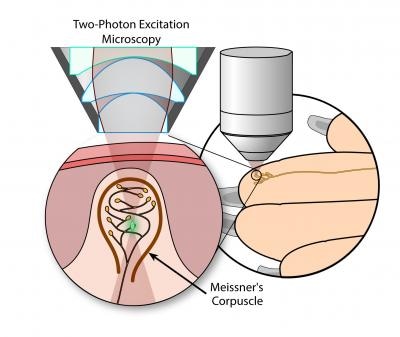Aug 31 2016
When a fingertip explores the surface of a material, mechanoreceptors called Meissner's corpuscles (MCs) near the surface of the skin mainly respond to low-frequency vibration stimuli such as fluttering or slipping on the skin. Thus they are responsible for sensitivity to light touch.
 MCs were labeled with a fluorescent lipophilic dye (orange) and imaged in living tissue by two-photon excitation microscopy (green). MCs are located in finger-like projections of the dermis called dermal papillae. Each MC consists of connective tissue-encapsulated nerve endings, which branch from a single nerve fiber, which itself branches from an afferent axon. (Figure is not drawn to scale) (CREDIT: NITech)
MCs were labeled with a fluorescent lipophilic dye (orange) and imaged in living tissue by two-photon excitation microscopy (green). MCs are located in finger-like projections of the dermis called dermal papillae. Each MC consists of connective tissue-encapsulated nerve endings, which branch from a single nerve fiber, which itself branches from an afferent axon. (Figure is not drawn to scale) (CREDIT: NITech)
Researchers at the Nagoya Institute of Technology (NITech) and Nagoya University (NU) have recently developed an in vivo imaging method to observe MCs in living skin. Not only could this imaging method unlock the mechanism of mechanoreceptor function, but could also be used as a novel diagnostic tool for neural diseases, and accelerate the study of aging-related neurodegeneration.
Previous studies, which involved observing MCs in cut sections of fixed tissues, have described the morphology and physiological functions of MCs, but the mechanism of mechanical transduction by MCs in living tissue remains unknown. The NITech-NU research team has now opened a window to understanding the mechanism of mechanoreceptor function by using two-photon microscopy to observe MCs in action, in situ in the fingertips of live mice.
Two-photon microscopy is a fluorescence-based technique that allows the imaging of living tissue, up to a depth of one millimeter, with high resolution and low phototoxicity. Using two-photon imaging, the NITech-NU scientists are the first to observe mechanoreceptors in vivo in non-transgenic tissue. "To visualize MCs, we used a nontoxic and long-lived fluorescent lipophilic dye that allows for extended time-lapse observation in the same individual", says Pham Quang Trung, a PhD Student of NITech, the leading author of this study. "The fluorescent dye persisted in injected mice for at least 5 weeks, and we successfully imaged the same MCs in a mouse paw three times over five days."
The basis of MC mechanotransduction is that light mechanical pressure on the skin causes physical deformation of a MC that results in an action potential. The NITech-NU scientists plan to investigate these pressure-induced changes in MC architecture with their new imaging methodology. Mr. Pham explains, "We have designed and built a specialized chamber that isolates and stabilizes a mouse's paw for two-photon imaging. This imaging chamber could be modified to provide controlled weight or vibration stimulations that result in different MC morphology transformations, which could then be monitored by two-photon microscopy." Mr. Pham adds, "We could combine our in vivo imaging method with microneurography to describe the relationship between changes in MC architecture and the traffic of nerve impulses."
A current limitation of this in vivo imaging method is that the lipophilic dye used only labels the neural components of the MC. Looking to the future, Dr. Sano, the principle investigator of the study comments, "To create a more complete model of MC structure and function, efforts will need to focus on developing two-photon-compatible in vivo labeling methods for other MC components, such as lamellar cells and the collagen capsule."
The ability to image MCs in vivo over extended periods of time, without toxicity or physical damage, has applications to human health. Human MCs decline in density with normal aging, and studies have reported changes in the shape, size and density of MCs in a number of neural diseases, such as peripheral neuropathies. Dr. Miyata, a senior scientist at NU and co-author of the study, concludes, "Our newly developed in vivo imaging method makes it possible, for the first time, to longitudinally track structural changes in human MCs for the diagnosis of neural diseases, and for the study of aging."
The article "Two-photon imaging of DiO-labelled Meissner corpuscle in living mouse's fingertip" was published in IEEE Transactions on Haptics at DOI 10.1109/TOH.2016.2574718